Answer these simple questions and we will find you the BEST prices
Which type of solar quotes do you need?
It only takes 30 seconds
100% free with no obligation

Get Free quotes from insulation specialists near you

Save money by comparing quotes and choosing the most competitive offer

The service is 100% free and with no obligation
- GreenMatch
- Insulation
- Floor Insulation
- Best Floor Insulation
Best Floor Insulation: Which Is Best For Your Floor?

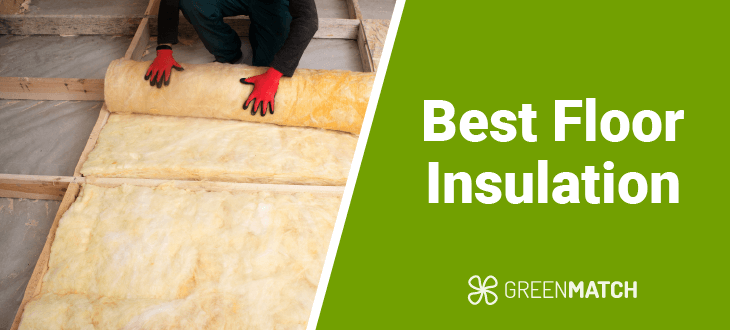
- One of the most efficient types of underfloor insulation is structural insulated panels, which offer both structural strength and high energy efficiency.
- Blanket insulation is one of the easiest and cheapest types of underfloor heating to install, with costs ranging from £5 to £10 per m².
- The best insulation in terms of life expectancy is rigid foam insulation, which can last up to 100 years and withstand different environmental conditions.
Did you know that without proper underfloor insulation, you can lose as much as 10% of the heat in your home during the winter months? So, to avoid wasting energy and your hard-earned money, it’s worth looking into what the best floor insulation options are for your home.
In this guide, we’ll walk you through the best types of floor insulation. These include:
- Multi-foil insulation: The best underfloor insulation for radiant heat control.
- Blanket insulation: One of the most versatile options in terms of the materials you can choose from.
- Rugs and carpets: One of the best floor insulation solutions for increased comfort and aesthetic appeal.
- Insulating screed: The best insulation option to pair with an underfloor heating system.
- Structural insulated panels: The best insulation in terms of structural strength.
- Draught proofing: The best form of insulation for a lower budget.
- Rigid foam insulation: The most durable form of underfloor insulation.
- Spray foam insulation: One of the best options when it comes to moisture resistance.
Once installed, you can save up to £110 on your yearly energy bills with these underfloor insulation solutions. However, it’s important to note that the costs of installing adequate floor insulation can be up to £4,700 for an average-sized home. So, to avoid breaking the bank, you’ll need to compare multiple quotes from certified installers.
Instead of wasting hours of your precious time looking up prices on your own, just fill in our 30-second form and we’ll send you quotes from up to 3 installers from our network. It’s quick, easy and completely free - so click below to get started!
- Describe your needs
- Get free quotes
- Choose the best offer
It only takes 30 seconds



Best underfloor insulation types 2025
Adding insulation to your floors has several benefits, such as increased energy efficiency, soundproofing, and reduced dampness in your home. As floor insulation prevents cold air from entering your home or warm air from escaping, you’ll also end up saving on your heating bills in winter with the right underfloor insulation.
To help you make an informed decision when picking the right insulation option for you, we’ll walk you through the best insulation for floors below:
Multi-foil insulation
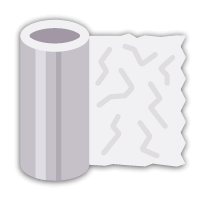
One of the best underfloor insulation options you can choose is multi-foil insulation. It consists of layers of aluminium foil and synthetic insulation also known as wadding. This thin and lightweight insulation is easy to install and can be used for floors, but also for roofs and walls.
Unlike other forms of insulation, which are designed to reduce conductive heat transfer, multi-foil insulation also reduces radiant heat transfer. This is possible because of the reflective properties of the aluminium foil, which prevents radiant heat from escaping your home.
In terms of how much multi-foil insulation costs, prices range from around £7 to £15 per m².
- Thin and lightweight material
- Easy to install by a professional
- Versatile
- Cheaper than other forms of underfloor insulation
- Moisture resistant
- Durable (50-year lifespan)
- Limited soundproofing
- Requires professional installation
- Possible condensation issues
Blanket insulation

Another one of the best flooring insulation materials you can opt for is blanket insulation. It’s typically made of fibreglass, but it’s also available in the form of mineral wool, plastic fibres, or even natural fibres such as cotton if you’re looking for an environmentally-friendly underfloor insulation option.
In terms of how it’s installed, the blanket material is laid as insulation between floor joists in suspended timber floors. Because it comes in rolls or batts that can easily be cut to adjust to the right size, this type of insulation is particularly easy to install whether you’re looking for a DIY solution or the expertise of a professional installer.
In terms of price, blanket insulation currently costs between £5 and £10 per m².
- Available in a variety of materials
- Affordable
- Easy to install (DIY or by a professional)
- Increases soundproofing
- Sensitive to moisture
- Shorter lifespan than other insulation materials (around 15 – 20 years)
- Less energy efficient than other materials
Rugs & carpets
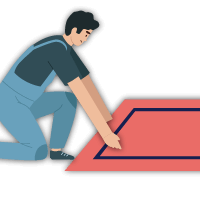
A form of floor insulation that may sometimes get overlooked is the addition of rugs or carpets to your home. They are a great solution if you have draughty floors, as they help reduce heat loss while also making your space more comfortable and aesthetically pleasing.
Some of the best options if you want to use carpets or rugs for insulation purposes are thick rugs made of materials such as wool or synthetic fibres like polypropylene. However, it’s important to note that carpets and rugs aren’t as effective as the other underfloor insulation options listed in this guide.
So, before investing in rugs or carpets, be sure to consider how well you need your floors to be insulated. This is especially important because they are more expensive than other floor insulation options, as they can cost anywhere from £6 to £70 or more per m².
- Aesthetic appeal
- Increased comfort
- Easy to upgrade
- Provide noise reduction
- More expensive than other types of insulation
- Less efficient than other insulation options
- May require more cleaning and maintenance
Insulating screed

Insulating screed is a mixture of cement, sand, and insulating materials like expanded polystyrene (EPS) beads. Because of its texture, it can be used not only for underfloor heating, but also as a leveller for your floors.
What makes insulating screed one of the best types of floor insulation is the fact that it’s compatible with underfloor heating systems. The insulation layer it provides ensures that the heat your system produces doesn’t escape. While it’s effective on its own, it may need to be paired with additional floor insulation in some cases.
When it comes to the cost of insulating screed, it ranges from £10 to £15 per m² on average.
- Compatible with underfloor heating systems
- Acts as a leveller for your floors
- Reduces noise transmission
- Cost-effective option
- May require additional insulation for optimal efficiency
- Sensitive to moisture
- More complex installation than other insulation options
Structural insulated panels
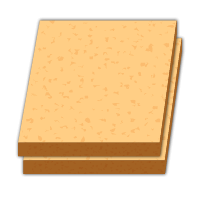
This form of underfloor insulation is known for its energy efficiency, as well as for the structural support it can offer to floors. Structural insulated panels consist of an insulating foam board made of polystyrene or polyisocyanurate placed between two sheets of oriented-strand board (OSB).
What makes structural insulated panels an exceptional choice for underfloor insulation is their strength and durability. Not only can they bear heavy loads, making them a great option for your floors, but they can also withstand high winds and even earthquakes. However, one of the drawbacks of this form of insulation is its high cost, which ranges from £50 to £155 per m².
- Structural strength
- Highly durable (lifespan of 60 – 75 years)
- Easy to install
- Low maintenance
- Reduce noise transmission
- High cost
- Require professional installation
- Difficult to change or remove
Draught proofing

As the name suggests, draught proofing refers to sealing any gaps or cracks in your floor that may let cold air enter your home or let warm air escape. The gaps are generally sealed with materials such as silicon or acrylic caulk.
It’s important to note that draught proofing can be an easy fix, but it’s not exactly a long-term solution. So, to maximise energy efficiency, it’s worth also installing underfloor insulation alongside your draught proofing efforts.
While draught proofing can be a cheap solution if you tend to it yourself, the costs are higher if you require the services of a professional. As a DIY project, you can expect to spend between £5 and £10 on the sealant of your choice. However, hiring a professional for the job can cost around £80 - £200.
- Cheap if done yourself
- Easy to install (even as a DIY project)
- Reduced noise transmission
- Less efficient than other insulation options
- Less durable than other forms of insulation
Rigid foam insulation

This type of floor insulation is made from materials such as polystyrene, polyisocyanurate (PIR), or polyurethane (PUR) and comes in the form of rigid sheets of varying insulation floor thickness or even in spray form. Rigid foam insulation has several applications, as it can be used on concrete floors, between floor joists, or under slabs.
Rigid foam is one of the best kinds of insulation for floors because of its impressive durability. The materials used to create it are resistant to degradation and various environmental conditions. When properly installed, it can last up to 100 years, providing your home with long-term energy efficiency.
Rigid foam insulation is also a cost-effective solution, as prices range from £5 to £15 per m².
- Highly durable (lifespan of up to 100 years)
- Easy to install
- Water resistant
- Versatile
- Increased soundproofing
- May require adjustments to your floor’s height
- Less environmentally-friendly than other materials
- Highly flammable
Spray foam insulation
Spray foam insulation is a material commonly made of polyurethane that is applied in liquid form and expands into foam as it dries up. There are two types of spray foam insulation: open-cell and closed-cell. The former has a softer texture and is less efficient, whereas the latter is more rigid and dense, offering both structural support and increased energy efficiency.
What makes spray foam insulation one of the best insulation solutions for floors is the fact that they are highly resistant to water. They act as a moisture barrier that can ensure that your home isn’t affected by mould or mildew.
However, it’s important to bear in mind that the costs of spray foam insulation are higher than those of other insulation materials, as they range from £30 to £70 per m².
- Highly durable (lifespan of 80 – 90 years)
- Versatile
- Reduced noise transmission
- Water-resistant
- Higher cost than other insulation options
- Difficult to remove
- Less environmentally friendly than other insulation options
What criteria did we use?
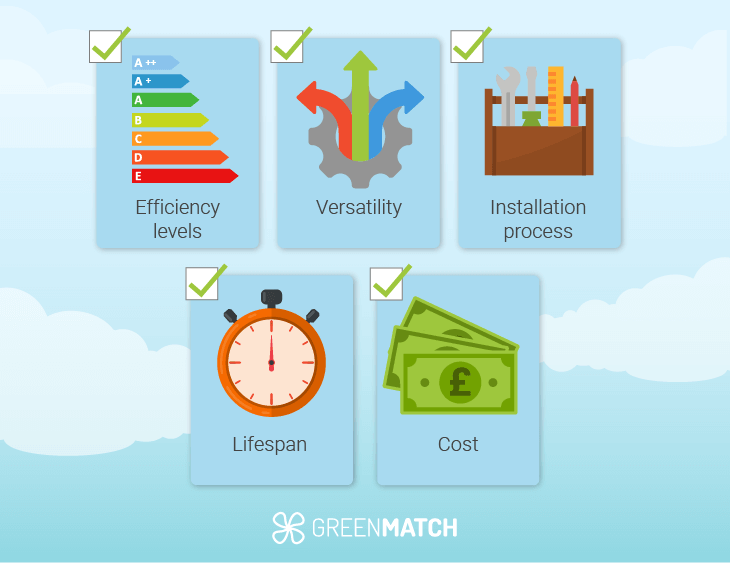
When creating our list of the best floor insulation solutions on the market today, we considered multiple factors, such as:
- Efficiency levels: All the types of insulation mentioned in this guide can increase your home’s energy efficiency, as they prevent cold air from entering your property, while also not letting warm air escape. This has significant implications for your comfort, but also for your savings, which can reach up to £110 per year if you install underfloor insulation.
- Versatility: In our list, we’ve included types of insulation made from a variety of materials. This way, you can make an informed decision when it comes to the kinds of materials you want to add to your home. At the same time, many of them have different applications and they can be beneficial not only as underfloor insulation, but also for other parts of your home.
- Installation process: As you have seen, one of the common advantages of most of the types of insulation we’ve mentioned in this guide is their easy installation. We’ve included this factor because the complexity of the installation will ultimately determine how much you’ll have to pay the installers for their services.
- Lifespan: How long you can benefit from underfloor insulation is a key consideration when choosing to invest in it. Most of the insulation solutions on our list have a long lifespan. This way, you can check which durable floor insulation is most suitable for you so that you can enjoy its benefits for years to come.
- Cost: When creating our list, we made sure to weigh the price-quality ratio of all the underfloor insulation materials we’ve mentioned. While some costs are quite high, especially if you also factor in installation costs, the quality of the materials can make your investment worth it in the long run.
Why choose new floor insulation?
You might not expect it, but floors account for around 10% of energy loss during the colder months if they’re not adequately insulated. So, to avoid overspending on your heating bills, especially as energy prices in the UK continue to fluctuate, it’s worth upgrading your floor insulation.
Additionally, adding underfloor insulation can increase the overall comfort of your home by regulating indoor temperatures and reducing noise transmission.
At the same time, if you’re not losing energy via your floors, you also won’t need to make use of extra energy. This can help you reduce your carbon footprint, as you’re limiting your reliance on fossil fuels to warm up your home.
Is floor insulation the right choice for my home?
If you’re looking to make your living space more inviting in a way that your bank account and the planet will thank you for, underfloor insulation might just be the right choice for you!
While floor insulation comes with multiple impressive advantages, one of its main drawbacks is the fact that it can be quite expensive to install. Finding the best floor insulation prices on your own can be a tedious process involving endless googling and reaching out to installers yourself. Who knows how long that might take?
Thankfully, we can help you get started in just 30 seconds. Simply fill in our short form and we’ll send you up to 3 quotes from local floor insulation installers. Then, you can easily compare information to secure the best deal for your home. Click below to get started now!
Fill in the form in just 1 minute
FAQ
Only you can decide what the “best” type of underfloor insulation is for your specific needs. That said, there are several highly-efficient options to choose from, such as blanket insulation, insulating screed, or rigid foam insulation.
There are multiple great options for underfloor insulation. The most efficient ones include rigid foam insulation, structural insulated panels, and blanket insulation. However, you should carefully consider which one would be most suitable for your specific situation.
Carpet is the best type of flooring when it comes to insulation properties. That said, adding carpet to your floors can be quite expensive, so be sure to check whether they really are the best option for you.
Rigid foam insulation is one of the best types of insulation for a floor cavity. However, you don’t have to commit to this type of insulation if you prefer another one. As long as you make sure that the cavity is filled, you can opt for any kind of insulation material you prefer.

Sabria Schouten is a content writer who aims to make information about sustainable energy broadly available. She believes that knowledge about how to lead a greener lifestyle should be easily accessible to anyone.
We strive to connect our customers with the right product and supplier. Would you like to be part of GreenMatch?


